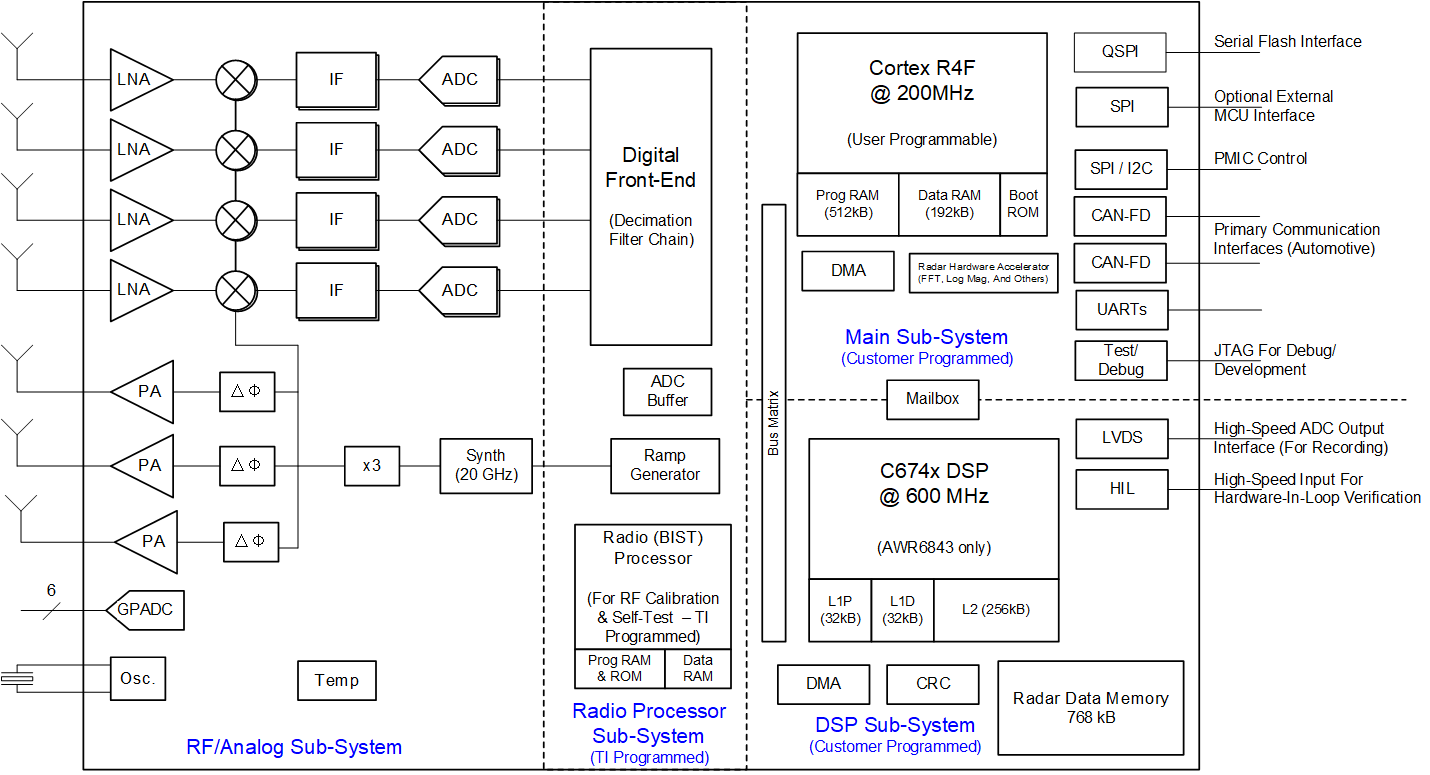-
AWR6443、AWR6843 单芯片 60GHz 至 64GHz 毫米波传感器
- 1 特性
- 2 应用
- 3 说明
- 4 功能方框图
- 5 Device Comparison
- 6 Terminal Configuration and Functions
-
7 Specifications
- 7.1 Absolute Maximum Ratings
- 7.2 ESD Ratings
- 7.3 Power-On Hours (POH)
- 7.4 Recommended Operating Conditions
- 7.5 Power Supply Specifications
- 7.6 Power Consumption Summary
- 7.7 RF Specification
- 7.8 CPU Specifications
- 7.9 Thermal Resistance Characteristics for FCBGA Package [ABL0161]
- 7.10
Timing and Switching Characteristics
- 7.10.1 Power Supply Sequencing and Reset Timing
- 7.10.2 Input Clocks and Oscillators
- 7.10.3 Multibuffered / Standard Serial Peripheral Interface (MibSPI)
- 7.10.4 LVDS Interface Configuration
- 7.10.5 General-Purpose Input/Output
- 7.10.6 Controller Area Network - Flexible Data-rate (CAN-FD)
- 7.10.7 Serial Communication Interface (SCI)
- 7.10.8 Inter-Integrated Circuit Interface (I2C)
- 7.10.9 Quad Serial Peripheral Interface (QSPI)
- 7.10.10 ETM Trace Interface
- 7.10.11 Data Modification Module (DMM)
- 7.10.12 JTAG Interface
- 8 Detailed Description
- 9 Monitoring and Diagnostics
- 10Applications, Implementation, and Layout
- 11Device and Documentation Support
- 12Mechanical, Packaging, and Orderable Information
- 重要声明
DATA SHEET
AWR6443、AWR6843 单芯片 60GHz 至 64GHz 毫米波传感器
本资源的原文使用英文撰写。 为方便起见,TI 提供了译文;由于翻译过程中可能使用了自动化工具,TI 不保证译文的准确性。 为确认准确性,请务必访问 ti.com 参考最新的英文版本(控制文档)。
1 特性
- FMCW 收发器
- 集成 PLL、发送器、接收器、基带和 ADC
- 60GHz 至 64GHz 的覆盖范围,具有 4GHz 的连续带宽
- 四个接收通道
- 三个发送通道
- 支持 6 位移相器
- 基于分数 N PLL 的超精确线性调频脉冲引擎
- TX 功率:12dBm
- RX 噪声系数:
- 12dB
- 1MHz 时的相位噪声:
- –93dBc/Hz
- 内置校准和自检
- 基于 Arm®Cortex®-R4F 的无线电控制系统
- 内置固件 (ROM)
- 针对工艺和温度进行自校准的系统
- 在符合功能安全标准的器件上提供嵌入式自监控,无需主机处理器参与
- 用于高级信号处理的 C674x DSP(仅限 AWR6843)
- 用于 FFT、滤波和 CFAR 处理的硬件加速器
- 存储器压缩
- 用于物体检测和接口控制的 Arm® Cortex®-R4F 微控制器
- 支持自主模式(从 QSPI 闪存加载用户应用)
- 具有 ECC 的内部存储器
- AWR6843:1.75MB,分为 MSS 程序 RAM (512KB)、MSS 数据 RAM (192KB)、DSP L1RAM (64KB) 和 L2 RAM (256KB) 以及 L3 雷达数据立方体 RAM (768KB)
- AWR6443:1.4MB,分为 MSS 程序 RAM (512KB)、MSS 数据 RAM (192KB) 和 L3 雷达数据立方体 RAM (768KB)
- 技术参考手册包括允许的大小修改
- 为用户应用提供的其他接口
- 多达 6 个 ADC 通道(低采样率监控)
- 多达 2 个 SPI 端口
- 多达 2 个 UART
- 2 个 CAN-FD 接口
- I2C
- GPIO
- 用于原始 ADC 数据和调试仪表的双通道 LVDS 接口
- 器件安全(在部分器件型号上)
- 支持经过身份验证和加密的安全引导
- 具有密钥撤销功能的客户可编程根密钥、对称密钥(256 位)、非对称密钥(最高 RSA-2K)
- 加密软件加速器 – PKA、AES(最高 256 位)、SHA(最高 256 位)、TRNG/DRGB
- 符合功能安全标准
- 专为功能安全应用开发
- 文档有助于使 ISO 26262 功能安全系统设计满足 ASIL-D 级要求
- 硬件完整性高达 ASIL-B 级
- 安全相关认证
- 经 TUV SUD 进行 ISO 26262 认证达到 ASIL B 级
- 也提供非功能安全型号
- 符合 AEC-Q100 标准
- 电源管理
- 内置 LDO 网络,可增强 PSRR
- I/O 支持双电压 3.3V/1.8V
- 时钟源
- 具有内部振荡器的 40.0MHz 晶体
- 支持频率为 40MHz 的外部振荡器
- 支持外部驱动、频率为 40MHz 的时钟(方波/正弦波)
- 轻松的硬件设计
- 0.65mm 间距、161 引脚 10.4mm × 10.4mm 覆晶 BGA 封装,可实现轻松组装和低成本 PCB 设计
- 小解决方案尺寸
- 运行条件:
- 结温范围为 –40°C 至 125°C
3 说明
该 AWR 器件是一款能够在 60GHz 至 64GHz 频带中运行且基于 FMCW 雷达技术的集成式单芯片毫米波传感器。该器件采用 TI 的低功耗 45nm RFCMOS 工艺制造,并且在超小封装中实现了出色的集成度。这是适用于汽车领域低功耗、自监控、超精确雷达系统的理想解决方案。当前提供多种符合汽车标准的型号,包括功能安全合规型器件和非功能安全器件。
器件信息
| 器件型号 | 封装(1) | 封装尺寸 | 托盘/卷带包装 |
|---|---|---|---|
| AWR6843AQGABLRQ1 | FCBGA (161) | 10.4mm × 10.4mm | 卷带包装 |
| AWR6843AQGABLQ1 | FCBGA (161) | 10.4mm × 10.4mm | 托盘 |
| AWR6843ABGABLRQ1 | FCBGA (161) | 10.4mm × 10.4mm | 卷带包装 |
| AWR6843ABGABLQ1 | FCBGA (161) | 10.4mm × 10.4mm | 托盘 |
| AWR6843ABSABLRQ1 | FCBGA (161) | 10.4mm × 10.4mm | 卷带包装 |
| AWR6843ABSABLQ1 | FCBGA (161) | 10.4mm × 10.4mm | 托盘 |
| AWR6443ABGABLRQ1 | FCBGA (161) | 10.4mm × 10.4mm | 卷带包装 |
| AWR6443ABGABLQ1 | FCBGA (161) | 10.4mm × 10.4mm | 托盘 |
(1) 如需更多信息,请参阅Section 12机械、封装和可订购信息。
4 功能方框图
图 4-1 展示了器件的功能方框图
 图 4-1 功能方框图
图 4-1 功能方框图Revision History
Changes from April 2, 2021 to January 10, 2022 (from Revision C (April 2021) to Revision D (January 2022))
- 通篇:进行了更新,以反映功能安全合规性;在主/从术语方面改用了更具包容性的措辞Go
- (特性):更新了功能安全合规性认证资料;添加了关于器件安全的详细信息;提及了毫米波传感器的额定工作温度范围Go
- (器件信息):添加了功能安全合规型安全量产器件 AWR6843ABSABLRQ1 和 AWR6843ABSABLQ1Go
- (Device Comparison) Changed/Updated to include AWR1843AOP; Updated/Changed the AWR6843AOP Product status from "AI" to "PD" Go
- (Device Comparison) Removed information on Functional-Safety compliance from the table and instead added a table-note for this and LVDS Interface; Additional information on Device security updated.Go
- (Signal Descriptions): Updated/Changed CLKP and CLKM descriptionsGo
- (Absolute Maximum Ratings): Added entries for externally supplied power on the RF inputs (TX and RX) and a table-note for the signal level applied on TX.Go
- (Clock Specifications): Updated/Changed Crystal Electrical Characteristics (Oscillator Mode) to reflect correct device operating temperature range.Go
- (Table. External Clock Mode Specifications): Revised frequency tolerance specs from +/-50 to +/-100 ppmGo
- (QSPI Timings):Updated/Changed Setup Time from 7.3us to 5us and Hold Time from 1.5us to 1us for QSPI TimingsGo
- (QSPI Timings): Updated/Changed Delay time, sclk falling edge to d[1] transition [Q6, Q9] from -3.5us to -2.5us (Min) and 7us to 4us (Max) in QSPI Switching CharacteristicsGo
- (Transmit Subsystem): Updated/Changed figure.Go
- (Monitoring and Diagnostic Mechanisms): Updated/Changed table header and description to reflect Functional Safety-Compliance; added a note for reference to safety related collateral Go
- (Device Nomenclature) : Updated/modified figure to reflect Functional Safety complianceGo
- Tray Information for ABL, 10.4 × 10.4 mm: Added tray information for secure part.Go